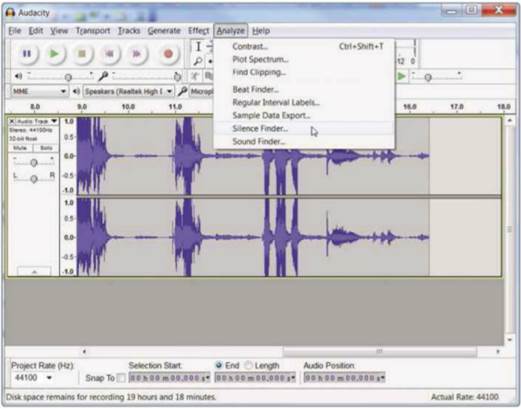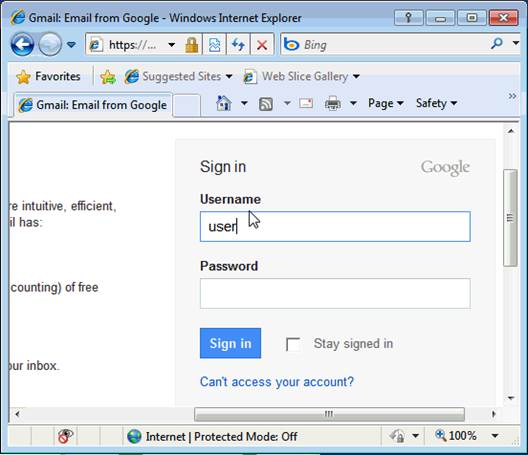How do I split my MP3 recordings?
Question
I have recently been trying to transfer
music cassette tapes to MP3 format using Audacity
(http://audacity.sourceforge.net). I play the tape and set Audacity to record.
While this works fine, unfortunately the Audacity software treats the album as
one long track. Is there a way of taking the one long track and dividing it up
into the dozen or so individual tracks that make up the album? Or must I record
each track individually? I am using Audacity 1.2.6 and I run Windows Vista.
Answer
You can do this manually or automatically,
depending on how accurate you want to be. First, though, we recommend updating
your version of Audacity, as 1.2.6 is now several years old. You can download
the latest version from www.snipca.com/8827.

Use
Audacity’s Silence Finder tool to detect gaps and split recordings
Let’s try the easy method first. Once
you’ve captured the recording, open the Analyze menu and choose Silence Finder.
This will look for quiet points in the audio and apply labels at the start of
each ‘noisy’ part. Next, choose Export Multiple from the File menu and Audacity
will save each labeled area as a separate file.
However, this method may not work well with
old or noisy recordings. So, to do the job manually, click to place the
selection cursor at the start of a song, then choose the Add Label at
Selection’ option from the Tracks menu (or use the keyboard shortcut Control
and B). Repeat for all tracks and follow our earlier instructions to save each
track as a separate file.
Do I need to update Windows Defender Offline?
Question
Your tip on page 45 of Issue 390 (to use
Windows Defender Offline) helped me to get rid of a Trojan that had
taken over my laptop, so many thanks for that. However, I have another Trojan
now, a month after the first, so I need to know if the same Snipca link
(www.snipca.com/8232) gives me up-to-date software, or does this number change
with time? I have just made a DVD using my desktop computer and ran a complete
scan on the laptop with the downloaded tool, and it hasn’t found the Trojan. I
have the 64-bit version of Windows 7 Home Premium.
Answer
If burned to a DVD, then Windows Defender
Offline should be considered useful only for one (or short-term) use. This is
because by its nature the downloaded virus definitions it holds will not be
updated - it is an offline tool, so does not connect to the online world. If
copied to a USB stick key, however, then the program will update itself before
running. As such, if you want to use Windows Defender Offline again via a DVD
disc, then you should download the program again, as Microsoft regularly
updates the virus definitions. In other words, only a newly downloaded version
will contain the latest virus information.

You
should not reuse a DVD version of Windows Defender Offline
However, our Snipca link
(www.snipca.com/8232) will continue to work as long as Microsoft keeps the same
website address for Windows Defender Offline. This is because all our shortened
addresses do is ‘point’ to another page (Microsoft’s own download links are
updated regularly).
Whatever has infected your PC, the latest
version of Windows Defender should be able to find it. Are you sure that you
didn’t accidentally create your new Windows Defender Offline DVD from an old
version of the download? If you download a new version of the tool to the same
folder, then it may, for example, be named ‘mssstool64 (l).exe’, rather than
‘mssstool64.exe’. If you double-click the mssstool64.exe file, you’ll simply be
creating a DVD with the old version of the tool.
Readers to the rescue
Question
The husband of a friend of mine has died
and his widow wishes to access his email account, which is with Gmail, but she
has neither the username nor the password. Is there any way of obtaining these?
All I can think of at the moment is that she will have to uninstall Chrome then
reinstall it and set up a new account in her name, but in doing this she will
lose any existing unread emails in the original account. Can anyone help?

Is
there any way of obtaining these?
Answer
Firstly, although both created by Google,
Gmail has nothing to do with Chrome, which is a browser (like Internet
Explorer). So there’s no need to uninstall Chrome. And Gmail can be used inside
any browser. I use it in Internet Explorer, but you can, of course, use it in
Chrome.
If she has access to the computer her
husband used, then open up each browser on the computer and see if it is
already logged into Gmail (you can leave yourself logged into Gmail within a
browser). So, if he used Chrome he may have left himself logged into Gmail. If
it is logged in to then at least you will have the Gmail address, and that is a
start. If not, contact some of his friends: if he has ever sent them an email,
they will have his email address. Once you have the address that is a start,
and you may be able to get his password from somewhere (Google, for example).
I suppose this is a reminder to all of us
to write an ‘electronic’ will showing the family how to access your important
computer-based systems such as email, Facebook and so on, when you should die.
We covered this sensitive topic in a
feature published in Issue 360. Here, the best bet is to follow Guilbert53’s
advice and then, when you have discovered the email address, visit www.snipca.com/4688
to learn how to accessed the deceased’s account.
Solving your problems
Our team of experts is on hand to help
solve PC problems. Read on to find out how
Please note that we can only reply through
the No Problem page - we can’t reply personally by email, telephone or letter.
Before sending in your query, please consider the following points as clear
preparation helps us identify and resolve problems much more quickly.
·
The operating system and model number of the PC
you are using.
·
Be specific about the problem - what exactly has
gone wrong?
·
Include details of anything that changed around
the time that the fault developed - have you recently installed new software or
hardware?
·
Make an exact note of any error messages the PC
displays.
·
Include screen grabs to show us what is on
screen when the problem occurs.